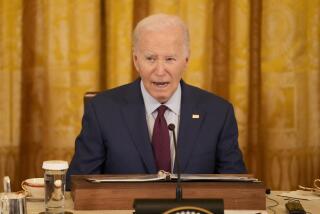Heading for the student debt cliff

Cable news channels regularly stoke their viewers’ fears about China holding $1.1 trillion of U.S. debt. But they’re focused on the wrong $1.1 trillion of loans.
The borrowers of this other $1.1-trillion debt are far more likely to default on their obligations: students, particularly those who went to for-profit colleges. The global consequences could be — and likely will be — staggering.
More than 38 million Americans have student loans outstanding. To put this in perspective, 38 million is the combined population of New York and Florida. And this collective debt is on par with the entire GDP of Mexico.
VIDEO: Obama decries rising cost of college education
After a for-profit culinary college in California settled a lawsuit brought by former students, I was hired by a fund created through the settlement to provide assistance to those who took out loans to attend the school. The job has put me on the front lines of the student debt crisis.
The students who enrolled at the culinary school were hoping to become the next Tom Colicchio, and they routinely took out $40,000 loans to finance their educations.
The federal government issued some of the loans to the students, but those covered only a portion of the school’s tuition and costs. Sallie Mae, the now-private lender, made up the difference, dispensing loans to students like Halloween candy. But there was a catch: Whereas the federal government’s loans had interest rates of about 6%, the interest rates on the private loans often hovered between 13% and 18%.
VIDEO: Don’t get in over your head with student loan debt
The financial consequences of financing a culinary education with credit card interest rates are devastating — and predictable. The school’s graduates who find work in their field typically earn about $9 per hour. And those are the lucky ones who are employed.
But repaying a $20,000 loan at 6% interest and an additional $20,000 loan at 15% interest is simply unsustainable for someone who earns an hourly wage of $9. The take-home pay does not come close to covering interest payments, and paring down the principal is not an option. Obviously, repayment is even less feasible for the unemployed.
Under the terms of the private loans, the missed interest payments are added back to the principal. Loan balances balloon. More payments are missed. The $40,000 loans quickly pass six figures.
One student I worked with illustrates the despair. Believing that education was the path to financial security, he financed his culinary education by taking out a $42,116 private loan — at 17.375% interest. Upon graduation, he could not find a culinary job in California, so he moved to Oklahoma. Unable to find employment there, he moved to Florida. Still, no jobs. He finally found work in Missouri, where he earns $11 per hour, 20 hours per week. But with two children, he isn’t making enough to live on, much less to begin paying back loan debt that, with interest, has increased to $110,000 (and continues to grow).
That is just one of millions of examples of the burden student loans have placed on so many Americans. They are graduates of culinary colleges, graphic-design schools, art institutes and healthcare training programs. Nearly half of all federal student loan defaults are by students who attend for-profit colleges, and 96% of students who enroll at for-profit colleges take out federal loans.
These loans leave many students entrenched in a permanent underclass. When they default — and they are defaulting in record numbers — the ripple effects spread from shore to shore, and beyond. They have no money to see movies, buy health insurance or, sometimes, even put dinner on the table. And when this many Americans are facing debt they can’t afford, businesses suffer from lower demand, tax revenues decline, and lenders face enormous losses.
This should sound eerily familiar. The situation is not unlike America’s recent housing crisis. In both cases, loans were doled out without regard to credit risks, and borrowers took on substantial debt they could not afford. Years of irresponsible, predatory lending finally caught up with mortgage issuers when homeowners lost their jobs and could not afford to repay their mortgages with interest rates that averaged 6.5%.
Now imagine the economic calamity if those mortgage interest rates had doubled to 13%. That’s the dire situation faced by unemployed and underemployed former students, who have neither steady jobs nor savings to cover tens of thousands of dollars in loans that seem to grow exponentially. We all know what happened to the housing market. Student loans are not far behind.
I have seen the front line of the student loan crisis. On the other side of the line is a cliff.
Adam B. Wolf is an attorney who specializes in student issues and civil rights matters.
More to Read
A cure for the common opinion
Get thought-provoking perspectives with our weekly newsletter.
You may occasionally receive promotional content from the Los Angeles Times.






